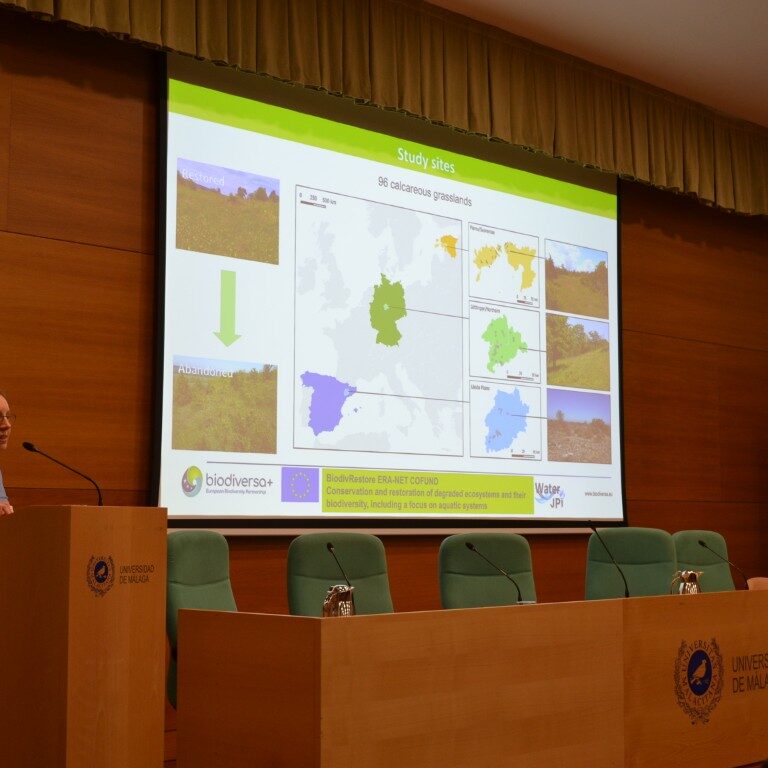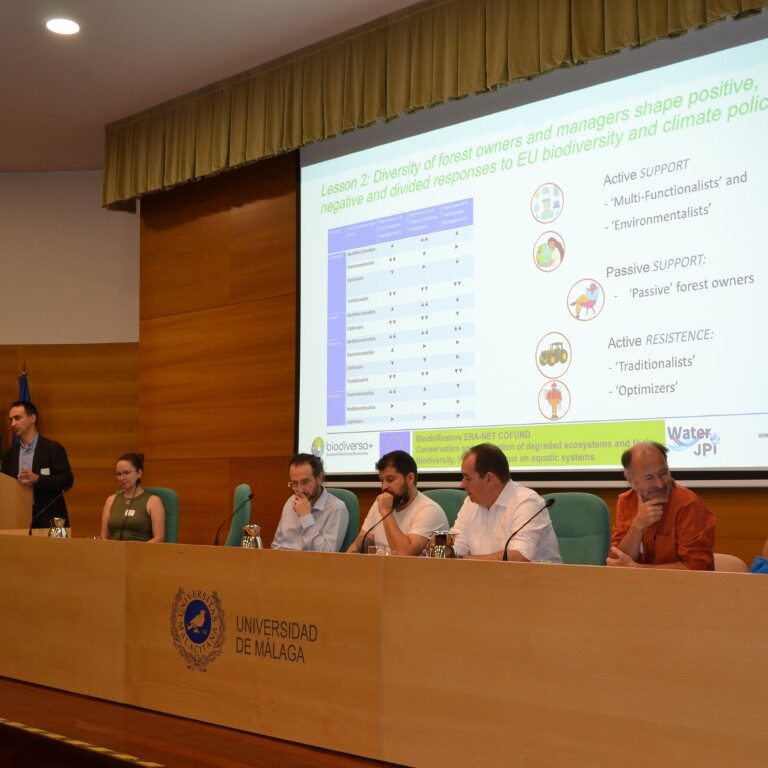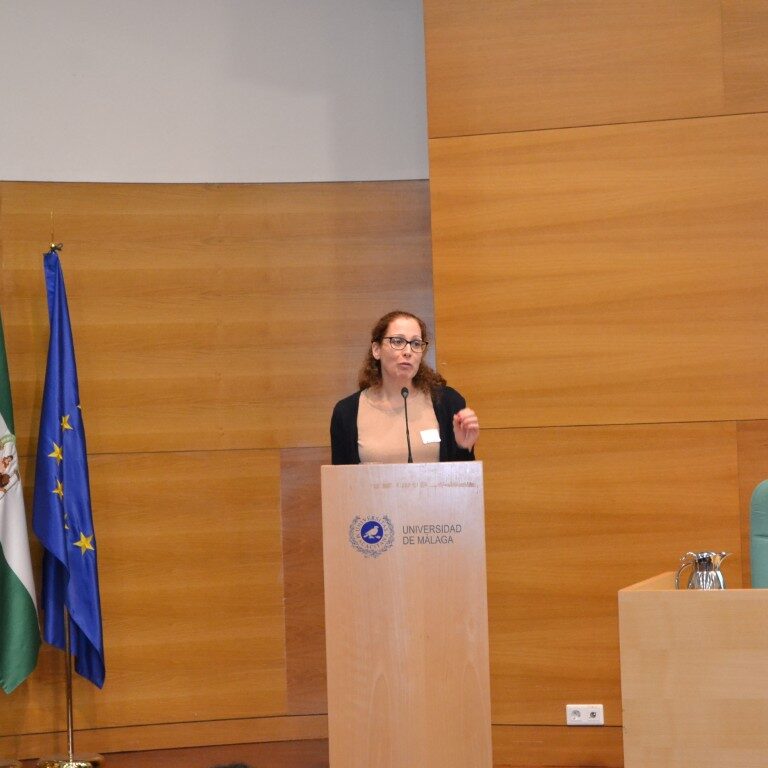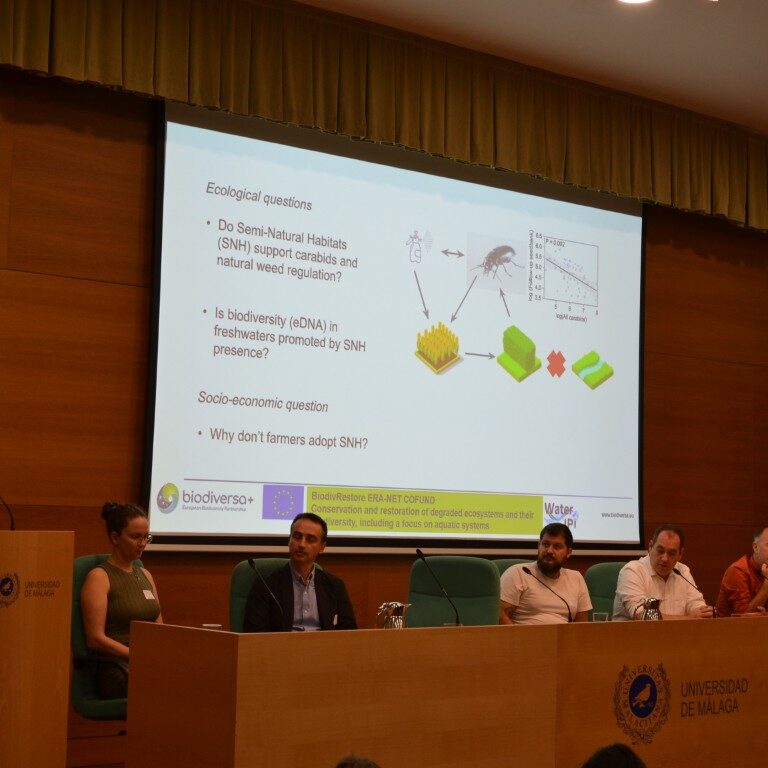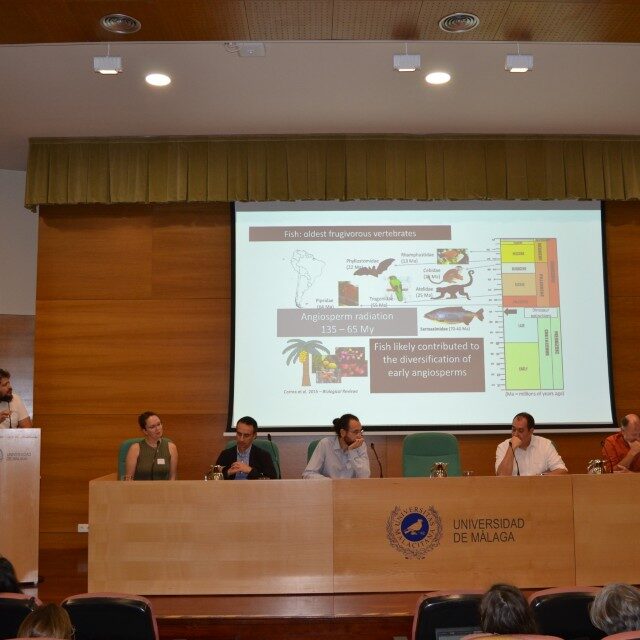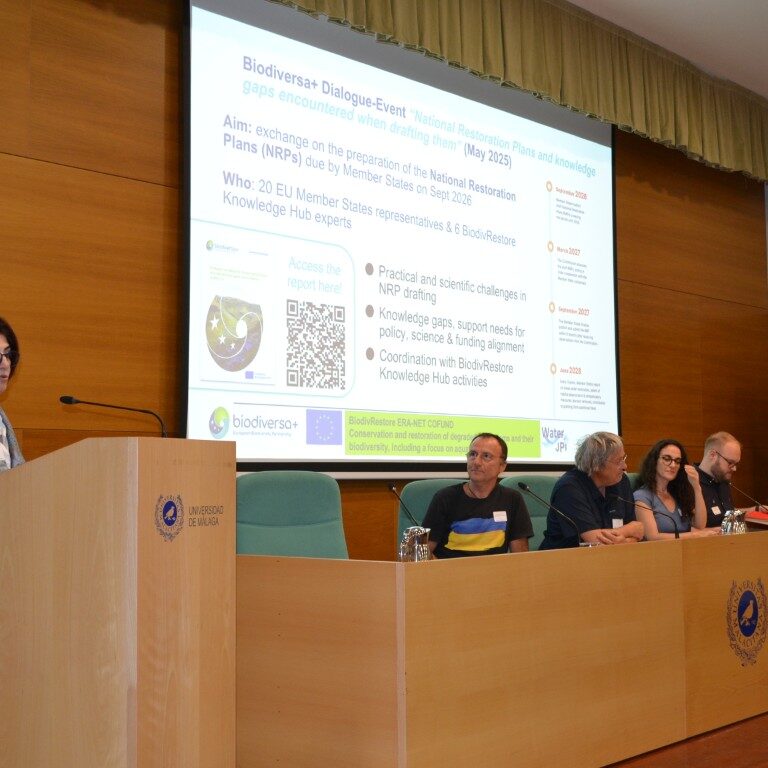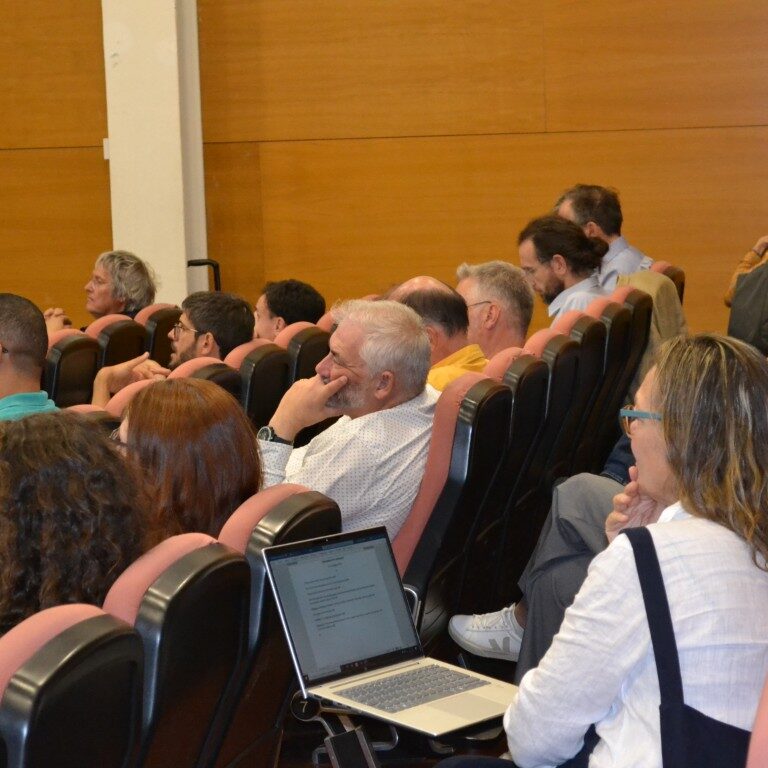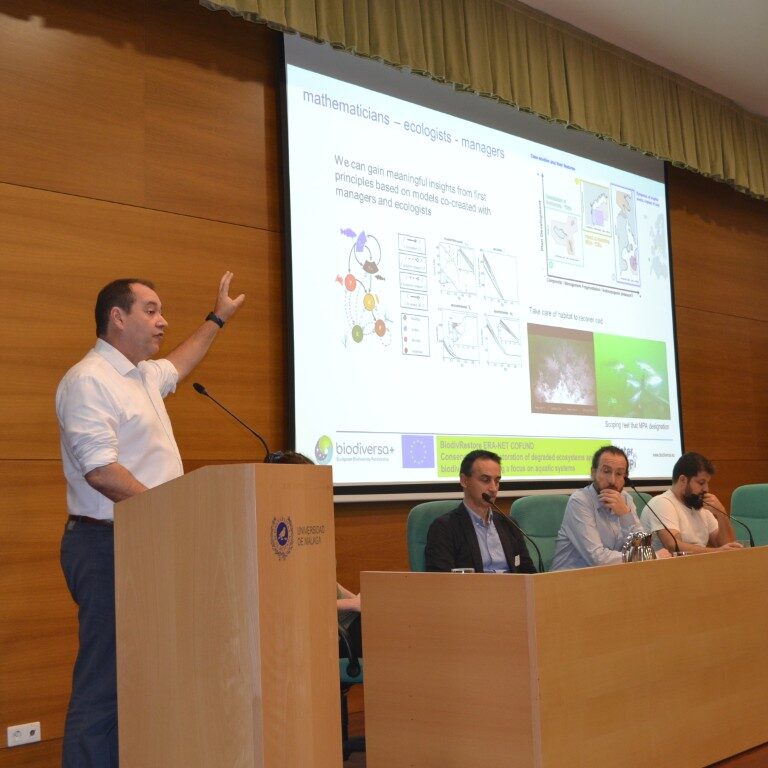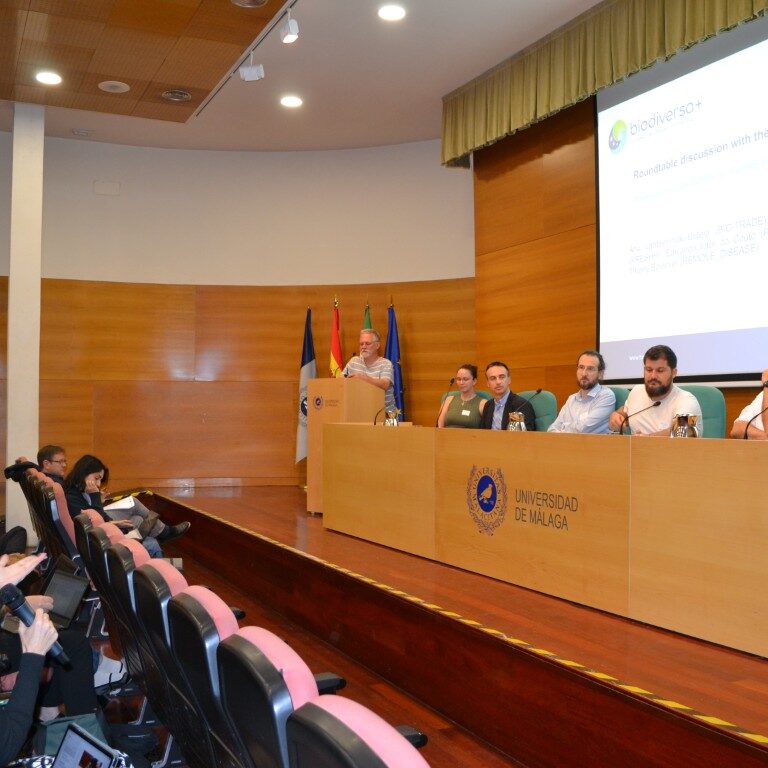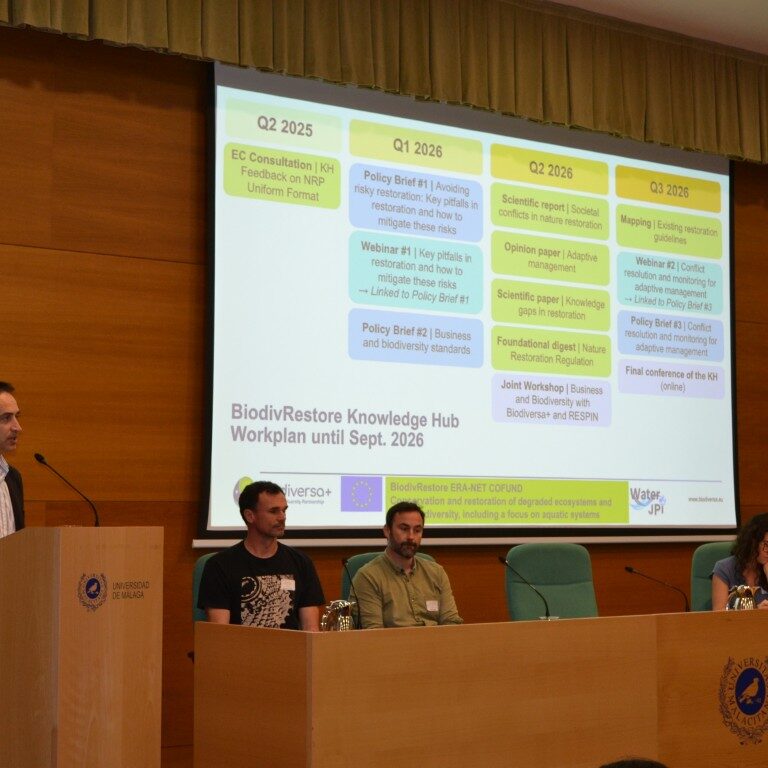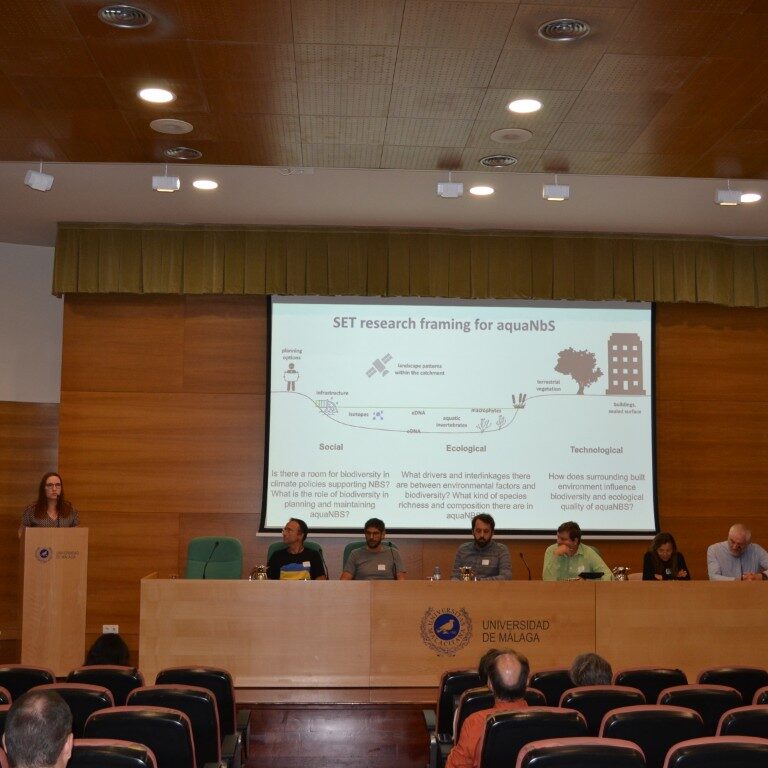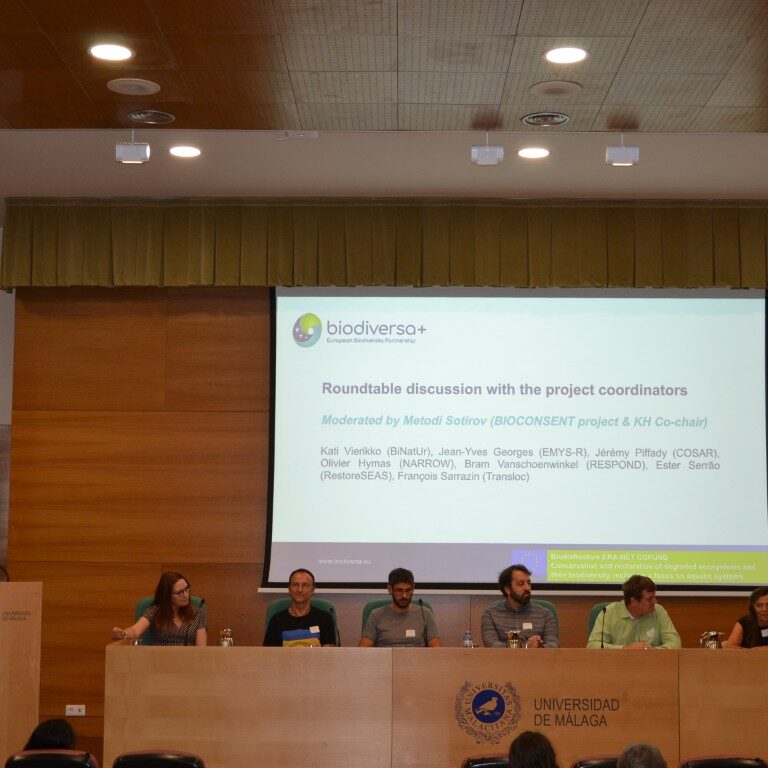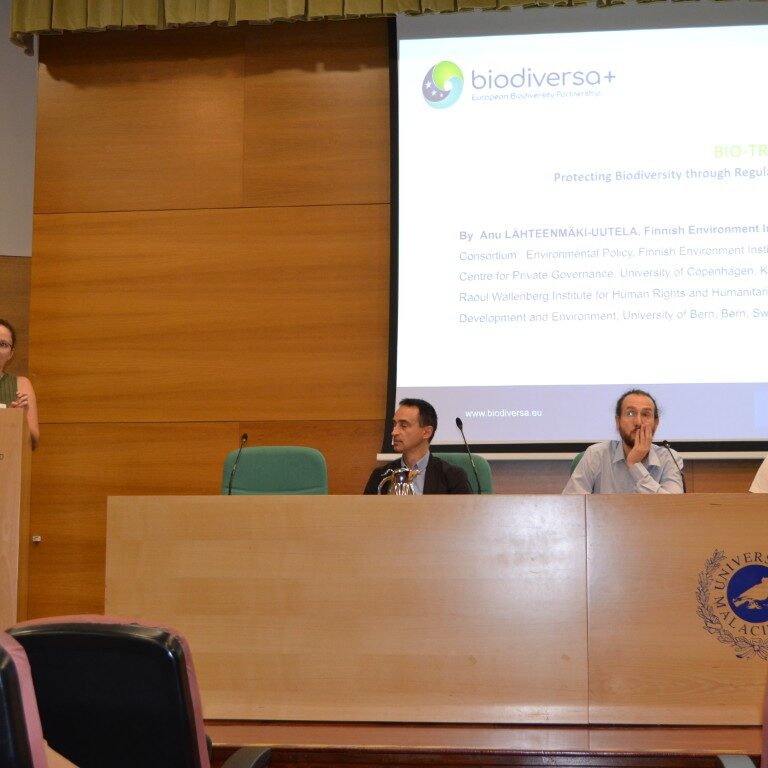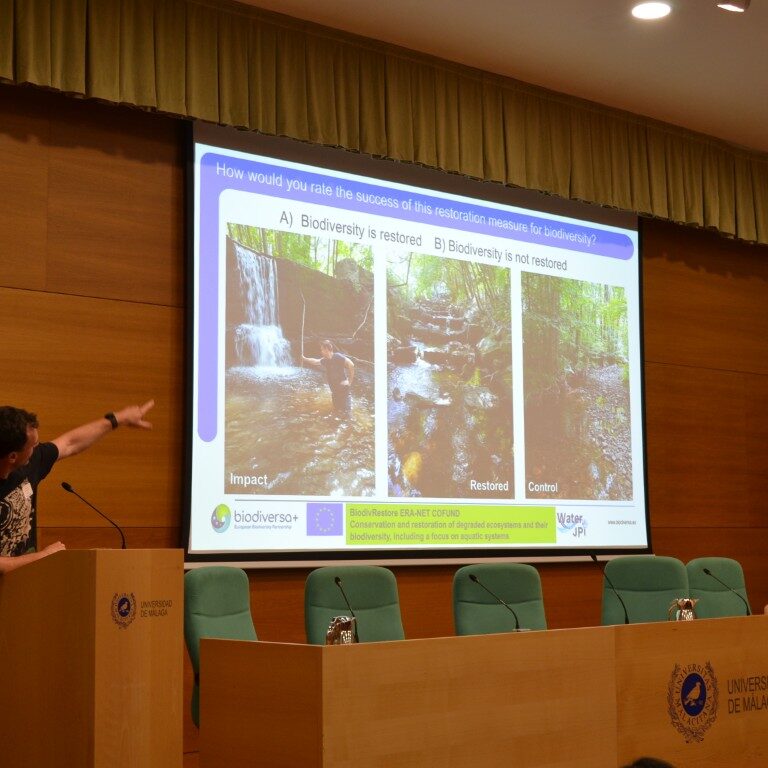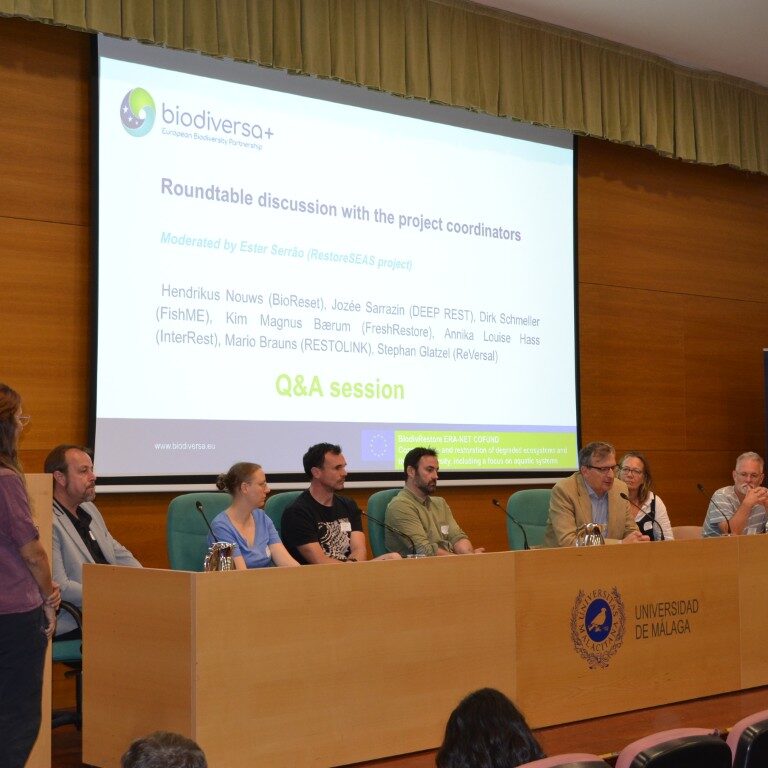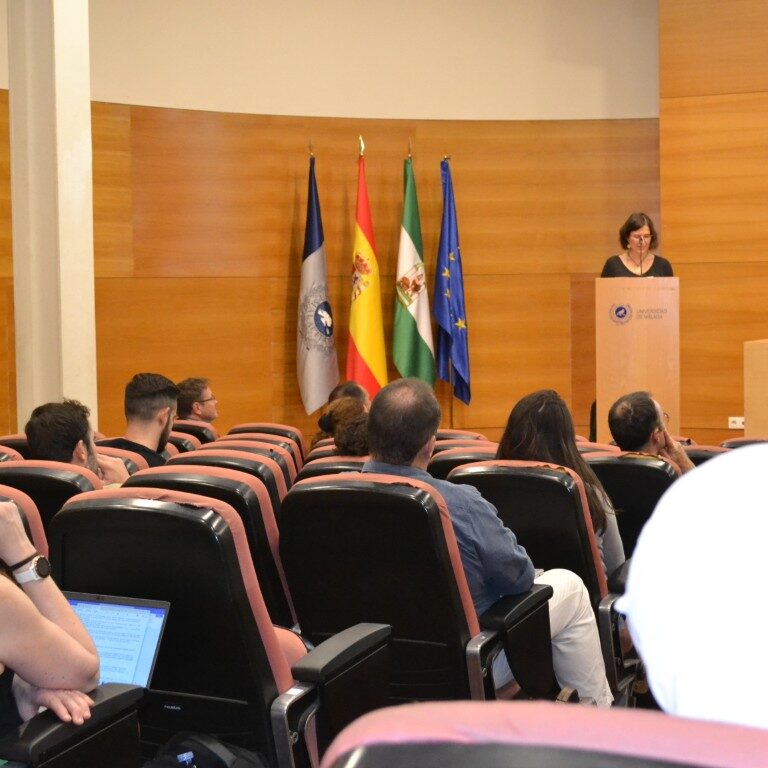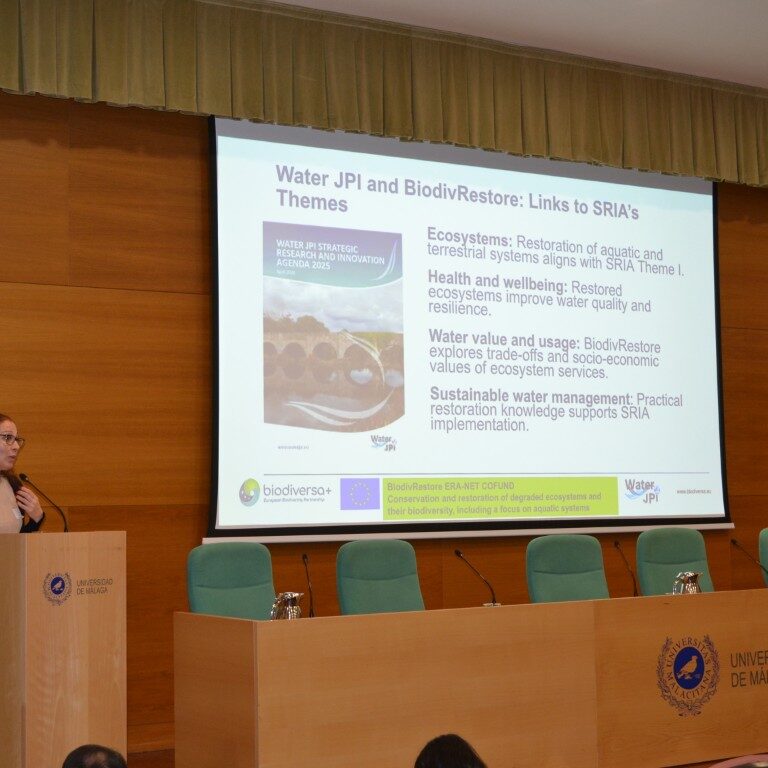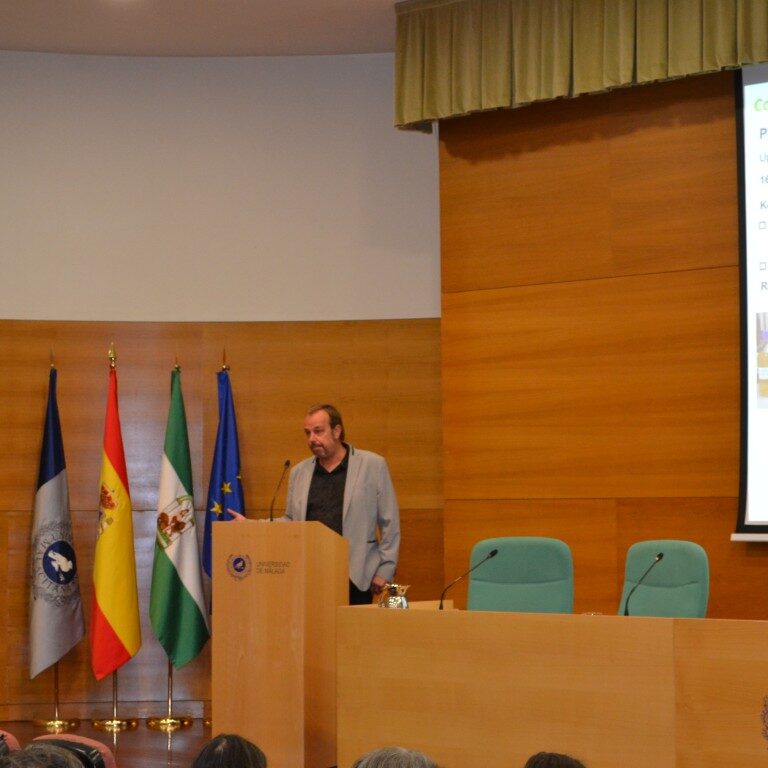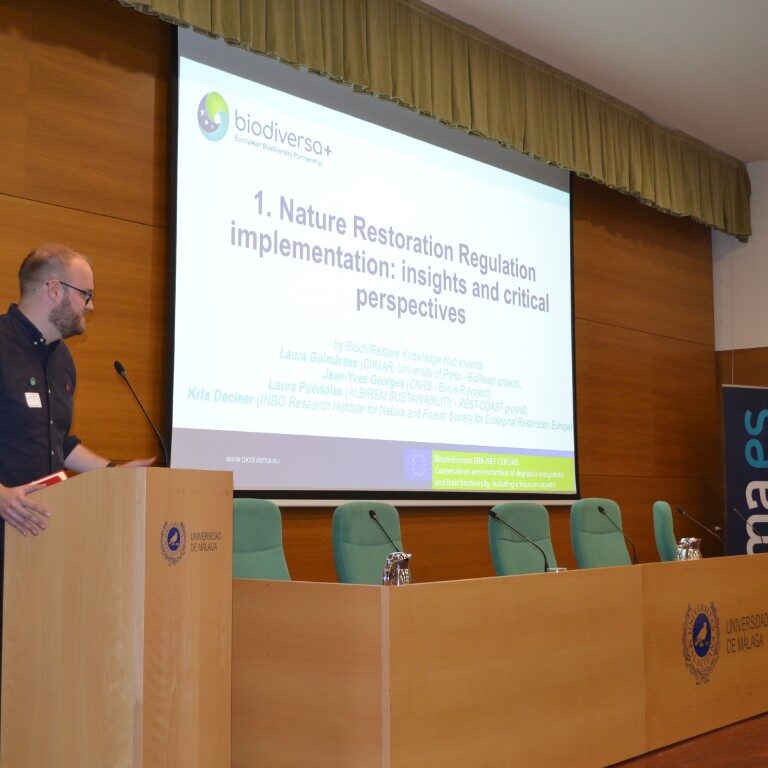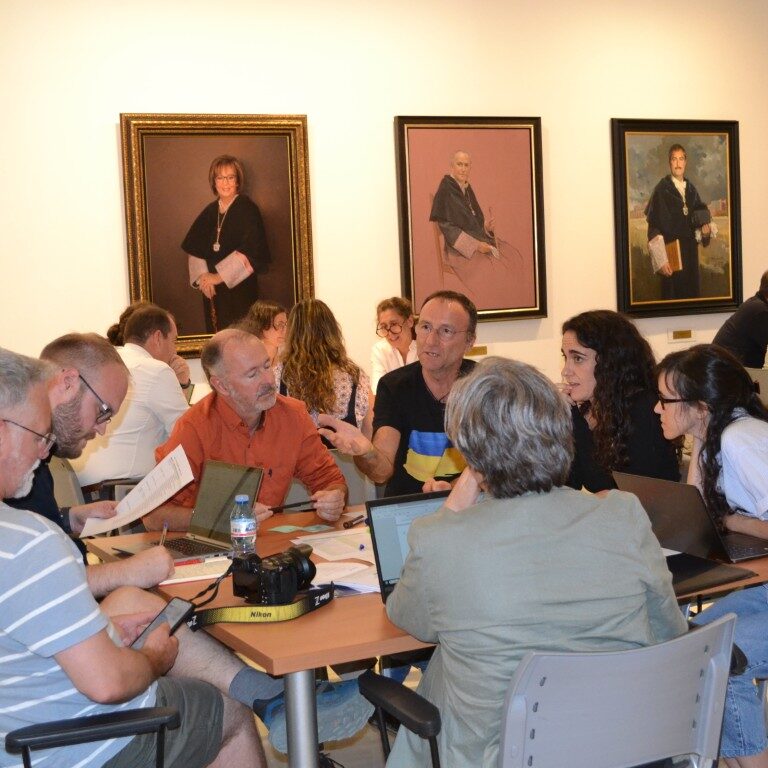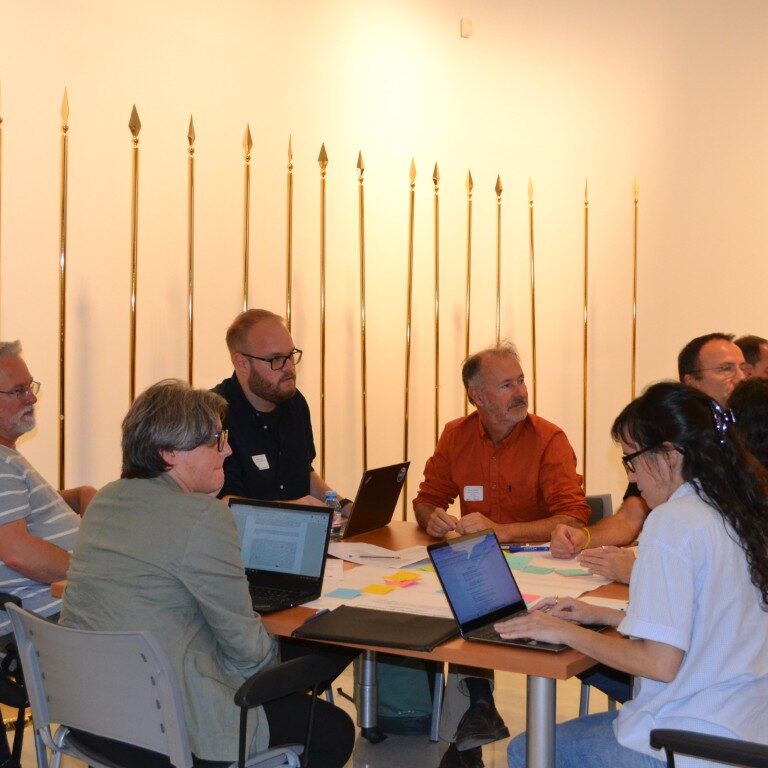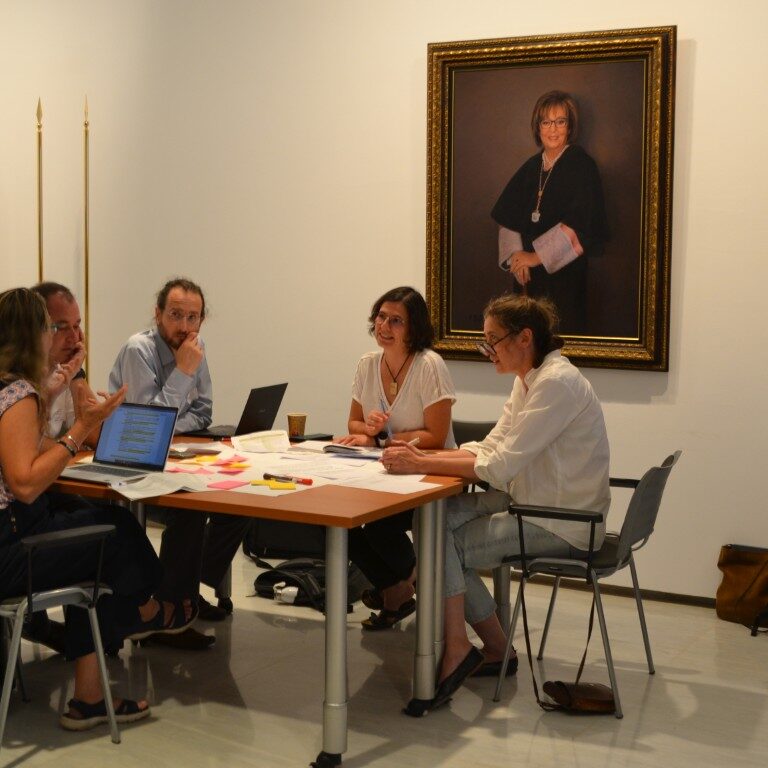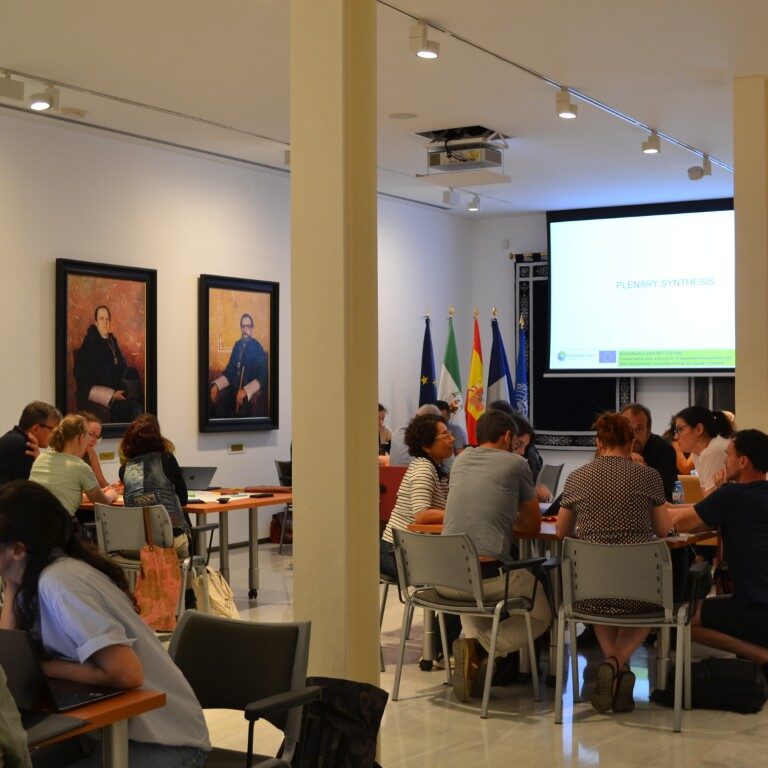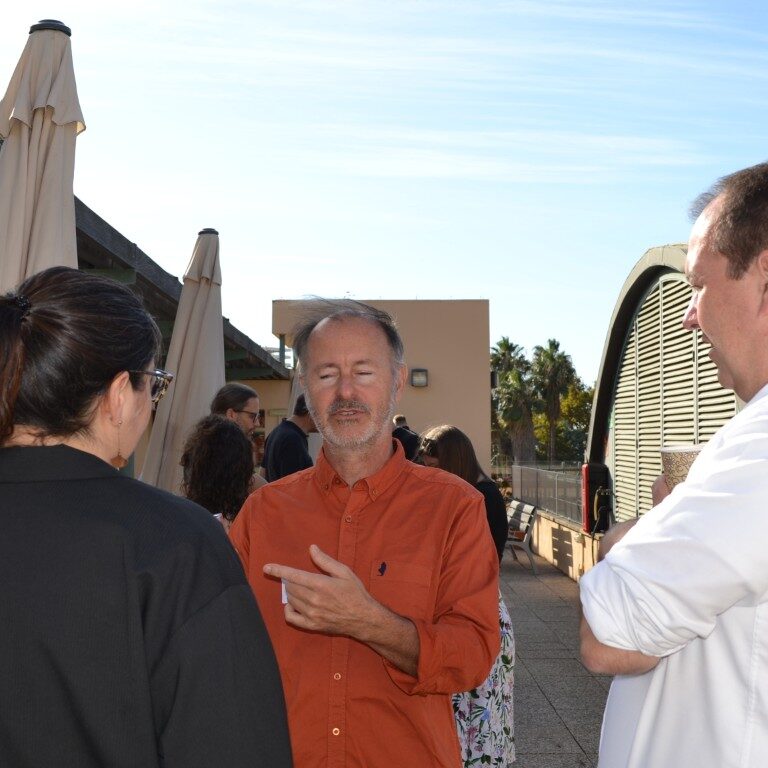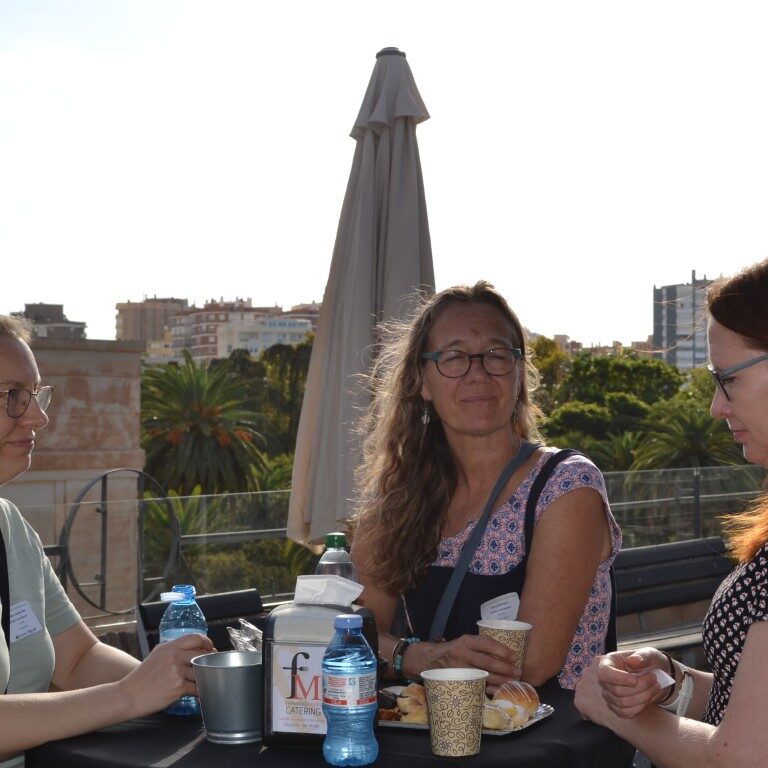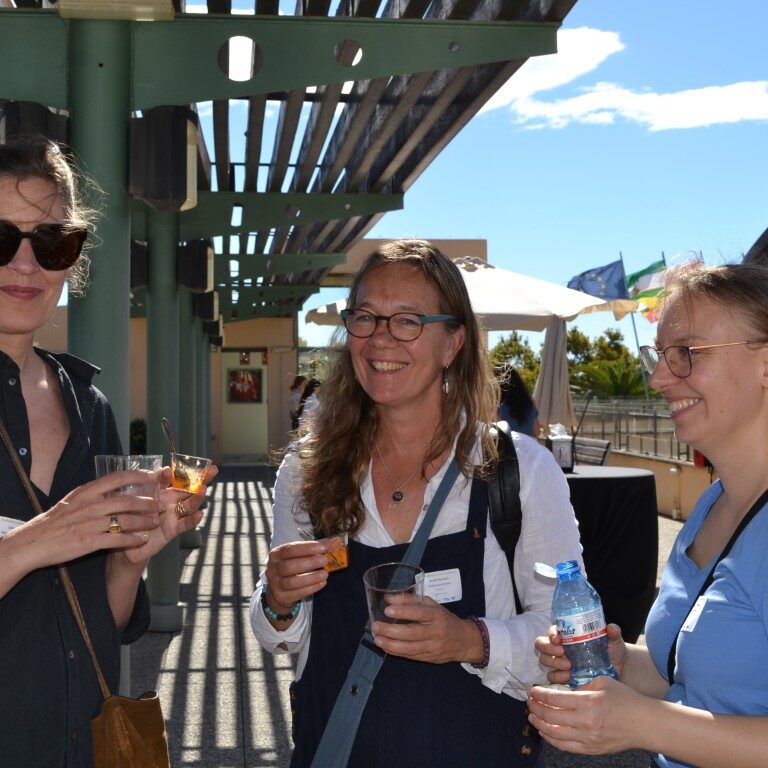Held at the University of Malaga on 21-22 October 2025, the BiodivRestore Final Conference brought together researchers, stakeholders, and policymakers to share the final results and achievements of the projects funded under the BiodivRestore Cofund Action, launched in 2020 in collaboration with Water JPI under Horizon 2020. The call focused on conservation and restoration of degraded ecosystems and their biodiversity, with a focus on aquatic systems.
The first part of the event focused on the BiodivRestore Knowledge Hub (KH), the interdisciplinary group of experts supporting the Nature Restoration Regulation (NRR) implementation and contributing to the Research and Innovation agenda on restoration. KH Experts shared updates on the implementation of the NRR, drawing on examples from France and Italy. They emphasised the need to scale up restoration efforts and discussed key tools like the Landscape-Ecological System Analysis (LESA), as well as the socio-economic benefits of the NRR, crucial factors for driving successful implementation. The KH also unveiled its workplan through September 2026, offering a closer look at upcoming activities.
The second part of the event featured presentations of the 22 projects and panel discussions, focusing on three themes:
- Biological and biophysical processes (Day 1)
- Trade-offs and synergies (Day 2)
- Knowledge for improving the effectiveness and upscaling of conservation and restoration actions (Day 2)
The third part of the event consisted of a workshop where the 22 projects worked together to develop the framework for four policy briefs providing actionable, evidence-based recommendations to support the implementation of the EU Nature Restoration Regulation, transforming scientific evidence into actionable policy inputs – advancing the EU’s ambition for large-scale, resilient nature restoration.
Highlights
Opening the session, Rainer Sodtke (co-chair Biodiversa+) presented the historical view of the 2020 joint call on ecosystem conservation and restoration, reminding that the project are still running at the moment, but will come to an end by next year.
Ondrej Kusbach (BiodivRestore Knowledge Hub Co-Coordinator) presented the Knowledge Hub, a group of 50 experts assisting EU Member States in implementing the Nature Restoration Regulation. The team is interdisciplinary, aiming to bridge research and practice through reports, policy briefs, and webinars until 2026.
Laura Guimãraes (BioReset) reported on the May 2025 dialogue-event “National Restoration Plans and knowledge gaps encountered when drafting them”. She highlighted the key challenges, barriers and opportunities encountered, emphasising the need for harmonized methods, better communication, and conflict resolution. All details can be found in the National Restoration Plans dialogue report.
Jean-Yves Georges (EMYS-R) outlined France’s view, noting resource gaps, contradictory laws, and public resistance. He advocated for participatory, science-informed, and adaptive conservation to make restoration laws and targets effective.
Laura Puertolas (Rest-Coast project) stressed the need to connect research, policymakers, and society to scale up restoration and highlight its ecological and socio-economic benefits. She highlighted the importance of cross-ecosystem, participatory approaches, clear communication of ecological and socio-economic benefits, and better governance to avoid project failures.
Kris Decleer (INBO Research Institute for Nature and Forest) presented the LESA (Landscape -Ecological System Analysis) as a tool to analyse ecological functions and understand how conditions changed over time, how climate change may affect those conditions in the future, and to identify potential targets and pathways towards recovery.
Metodi Sotirov (co-chair of the KH, BIOCONSENT) presented the Knowledge Hub’s workplan through 2016, offering a closer look at upcoming activities (policy briefs, webinars, workshops…).
Mario Brauns (RESTOLINK) reported survey findings showing key knowledge gaps in socio-economic, socio-cultural, and climate-related aspects of restoration.
Kim Magnus Bærum (FreshRestore) introduced the group on adaptive management, exploring key aime and ongoing work. The group notably analyses scientific and grey literature to identify success factors and produce concrete recommendations for effective implementation.
Metodi Sotirov followed with an introduction on societal conflicts around restoration, examining their ideological, economic, political and institutional roots and ways to reduce them.
Laura Puertolas concluded with insights on public-private partnerships (PPPs) to boost nature restoration funding. She stressed the need for local community inclusion and long-term commitment.
BioReset evaluated environmental pollution and treatment technologies and their efficiency regarding two types of contaminants : pharmaceuticals and microplastics.
The project main results include, among others:
- Emerging pollutants were identified in several environmental compartments.
- Biochar and hydrochar materials produced from agri-industrial waste can significantly enhance the adsorption and removal of pharmaceuticals from wastewater.
- Fungal-based treatment systems can efficiently degrade pharmaceuticals while producing minimal transformation by-products.
- Raman spectroscopy combined with diatoms can indicate water and ecosystem quality.
DeepRest worked on the conservation and restoration of marine ecosystems in the context of deep-sea mining. As the regulations about deep-sea mining are currently under development, the project stressed the urgent need to inform decision-makers and the general public.
Among other findings, the project demonstrated that:
- Passive restoration cannot achieve full recovery of deep-sea ecosystems once habitat structure and ecosystem functions are lost, even if connectivity is ensured.
- Governance frameworks should integrate ecological, geopolitical, socioeconomic, technological, and legal dimensions to ensure balanced and informed decision-making.
FishME studied how fish removal in mountain lakes can help ecosystems to recover, highlighting various challenges.
Key results of the project are notably:
- Ecological restoration in high-mountain lakes is a slow process, requiring long-term monitoring and persistence.
- Fish removal enables measurable ecological recovery, with amphibian populations and aquatic biodiversity rebounding once introduced fish species are eradicated.
- The FishMe Management Toolbox strengthens awareness and policy support, helping local authorities and stakeholders to better understand and manage the ecological impacts of fish introductions.
FreshRestore explored the ecological and socio-economic impacts of environmental drivers and cumulative human stressors in freshwater systems.
Some of the project results are:
- Human pressures such as species invasions and reduced buffer zones shift energy flows and weaken lake resilience.
- Coupling ecological and socio-economic models helps evaluate restoration trade-offs and stakeholder benefits.
- It worked on modular adaptive management tools to predict holistic effects of different restoration efforts.
InterRest focused on calcareous grassland and its rich biodiversity. The project studied the effect of farmer and agricultural management on biodiversity, based on a management index going from long-term abandonment to intensive management.
Among others, the projects key results include:
-
Low-intensity grazing is essential to maintain typical plant species and biodiversity in calcareous grasslands.
-
Higher landscape connectivity through surrounding grasslands enhances pollinator richness and bird predation.
-
Farmer motivation and socio-ecological integration improve restoration effectiveness and management practices.
RESTOLINK quantified restoration success across biomes by linking biodiversity, multifunctionality, and hydromorphological heterogeneity. Using an index of restoration success, the project evaluated river restoration impacts on biodiversity and ecosystem function.
Key results of the project are notably:
-
Ecosystem function proved to be a sensitive and complementary indicator of restoration success.
-
Restoring river connectivity enhanced macroinvertebrate diversity beyond its primary goal of fish migration.
ReVersal focused on peatland restoration in temperate Europe (Austria, Poland, Germany, the Netherlands, Sweden). It analysed peat cores to reconstruct past hydrology, vegetation, pollution, and degradation, helping understand how these ecosystems respond to human impact.
Here are three of the project’s key results:
-
Peatlands showed strong ecological resilience.
-
Restoration objectives such as hydrology, biodiversity, and carbon storage can be conflicting, requiring site-specific and balanced management approaches.
-
Successful restoration depends on long-term stakeholder engagement and trust-building beyond short project cycles.
COAST focused on the marine ecosystems of Cabo Verde. It aimed to build the first scientific baseline on marine biodiversity, habitats, and ecosystem functions to guide marine conservation and policy.
Among other findings, the project demonstrated that:
- Collaborating closely with local fishers enhances data collection and ensures that restoration actions align with community needs.
- Early restoration trials reveal which coral species are most viable for recovery, guiding future large-scale restoration efforts.
This first session of project presentations concluded with a roundtable discussion and a Q&A, addressing key conceptual and practical questions in ecological restoration.
BIO-TRADE studied how European trade and business laws can reduce global biodiversity loss caused by EU consumption. It analysed trade, business, and human rights law, and recent EU measures like the deforestation and due diligence regulations.
Among other key findings, the project demonstrated that:
- European consumption and trade policies are major global drivers of biodiversity loss.
- The concept of ‘nature-positive’ or ‘regenerative’ business is redefining corporate responsibility toward biodiversity.
BIOCONSENT analysed how EU forest and biodiversity strategies are translated into national policies and management practices, how forest owners and managers respond to these objectives, and how different policy and management approaches affect forest ecosystems.
Some of the project’s insights indicate that:
- Countries showed contrasting reactions to EU forest biodiversity and forest strategies, with Sweden being reluctant, Germany divided, and Spain supportive.
- The diversity of forest owners strongly influenced their responses to EU forest policy objectives.
- Land sharing and close-to-nature forest management were identified by experts as the most preferable restoration approaches.
FRESHH studied how herbicides and semi-natural habitats interact in agricultural landscapes. It examined how such habitats support beneficial insects, reduce herbicide runoff, and enhance biodiversity in nearby waters, while also exploring farmers’ motivations and barriers to adopting these restoration practices.
Analysis across case studies notably highlighted that:
- Semi-natural habitats supported higher biodiversity and contributed to maintaining ecosystem functions in agricultural landscapes.
- Most farmers were open to implementing semi-natural habitats, though many required financial incentives to do so.
ForestFisher studied the critical, yet threatened, interaction between flooded forests of the Amazon Basin and the frugivorous fish that depend on them. These fish are not only key to forest regeneration through seed dispersal but also represent a vital source of food and income for local communities. The project also worked on policy support, capacity building, and community engagement to promote sustainable fisheries and conservation.
Among others, key findings from the project show that:
- A definitive ecosystem link exists between the richness of frugivorous fish species and the extent of flooded forests, the duration of floods, and the diversity of forest trees, providing a scientific foundation for advocating forest and water flow conservation.
- Climate change, overfishing, and river fragmentation are already driving fishers’ displacement, revealing strong socio-ecological impacts across the Amazon basin.
- Long-range projections of frugivorous fish distributions and forecasts of future trajectories of deforestation and agricultural expansion have yielded priority areas for conservation and restoration of flooded forests.
- Collaborations with local communities, including women’s groups, have enhanced awareness of biodiversity conservation and climate challenges through participatory activities.
MPA4sustainability focused on improving the effectiveness of Marine Protected Areas (MPAs) for biodiversity conservation and ecosystem services provision.
The project main results include, among others:
- Development of integrative measures of biodiversity risk.
- Strict reserves excluding most human activities show the lowest biodiversity risk, while MPAs designated for single species or habitat face the highest risk.
- Collaborative modeling and data tools co-developed with managers improved local decision-making and are being applied in real MPA contexts.
- Ecosystem-based and integrative biodiversity management approaches are essential to understand how to reduce cumulative human impacts to have a net biodiversity risk reduction.
REMOVE_DISEASE explored how removing introduced mammals from sub-Antarctic islands can support biodiversity restoration and influence the dynamics of infectious diseases in seabird populations. It combined fieldwork, lab analysis, and disease surveillance to understand links between invasive species, disease spread, and ecosystem health, highlighting the importance of integrated conservation approaches under climate and biodiversity change.
Key results of the project are notably:
- Real-time response to emerging avian influenza outbreaks highlighted the value of integrated, collaborative approaches combining restoration, surveillance, and crisis management.
- Eradicating introduced mammals can provide indirect disease-related benefits for seabird populations, linking restoration to disease ecology.
NICHES explored how nature-based solutions (NbS) can improve urban stormwater management and reduce flood risks in cities. It developed models and participatory tools for inclusive planning, showing that NbS work best when combined with hybrid infrastructure and good governance.
Key findings from the project show that:
- Incorporating citizen knowledge and governance insights through participatory tools enhanced the inclusiveness and effectiveness of urban planning for nature-based stormwater management.
- Co-developing transition pathways with cities demonstrated how hybrid, nature-based strategies can build long-term urban resilience to flooding and climate impacts.
The session ended with a roundtable. The discussions focused on governance, ecological prioritization, and challenges in implementing environmental regulations such as the EUDR. Speakers emphasized the need for dialogue between science, business, and policy, greater supply chain transparency, and an inclusive land–sea approach to biodiversity restoration. The debate addressed barriers to a common EU forest policy, harmful forestry subsidies, and the benefits of collective forest management. Speakers highlighted the need for polycentric and locally adapted governance, balancing ecological, social, and economic goals, and aligning incentives to support long-term biodiversity restoration.
BiNatUr showed that aquatic nature-based solutions like stormwater ponds and small streams can enhance urban biodiversity and ecosystem services.
Some of the project’s main insights indicate that:
- Well-planned and managed aquatic nature-based solutions can effectively support biodiversity, including macroinvertebrate communities.
- Systematic monitoring is essential to assess how aquatic nature-based solutions deliver ecosystem services and support biodiversity.
- Integrating maintenance and monitoring more closely with implementation improves the long-term success of urban aquatic nature-based solutions.
Emys-R assessed wetland restoration to support the reintroduction of the European pond turtle (Emys) and related biodiversity. It studied how restoring wetlands can improve habitat quality and public connection to nature.
The project main results include, among others:
- Long-term monitoring, adaptive management, and local stakeholder involvement are essential for successful restoration and reintroduction.
-
Wetland restoration enhanced habitat quality and biodiversity, though effects declined over time and varied across sites.
COSAR developed new ways to assess the ecological and social impacts of river restoration. By analyzing extensive monitoring datasets and social media images, it showed that larger, well-planned projects in degraded areas yield stronger benefits.
Some of the project key results are:
- Larger and more ambitious restoration projects achieved larger ecological improvements, especially in degraded urban and agricultural landscapes, but final reached state needs to be individually checked.
- Functional diversity may continue to increase long after species richness had plateaued, showing long-term ongoing ecological change that only multi-metrics assessment can explore.
- The project highlighted the need for standardized monitoring designs to allow future larger assessment of restoration outcomes across Europe.
NARROW questioned the idea that Europeans are disconnected from nature.
Here are three of the project’s key findings:
- Rural communities across Europe remain strongly connected to nature, disproving the widespread idea of a European “disconnection” from the natural world.
- European conservation policies often overlook rural and collective governance systems, leading to an incomplete understanding of how people contribute to and co-manage nature.
- It calls for more inclusive, community-based conservation approaches that value local narratives and contributions alongside scientific perspectives.
RESPOND highlighted the ecological importance of temporary ponds, an overlooked habitat, showing they host unique species, support biodiversity, and even reduce mosquitoes.
Among other findings, the project demonstrated that:
- Experiences from practitioners showed that pond creation often delivers inconsistent outcomes, highlighting the value of learning directly from field-based knowledge.
- Temporary ponds proved to be multifunctional habitats supporting biodiversity and positive public engagement, reinforcing their relevance for broader European restoration strategies.
RESTORESEAS studied marine forests of algae, seagrass, and corals to guide restoration under climate change.
Key results of the project are notably:
- Climate-driven range shifts and mapped genetic diversity hotspots reveal where future conservation and restoration should focus to secure resilient marine forests.
- Long-term monitoring shows that natural ecosystems deliver higher and more stable functions than restored sites, emphasizing conservation as the most effective approach.
Transloc explored conservation translocations of plants, animals, and fungi.
Some of the project results are:
- By building an open database of 1,700 translocated populations, it assessed ecological and evolutionary impacts and promoted standardized success criteria to guide restoration under climate and connectivity changes.
- Conservation translocation can aid biodiversity restoration but remains complex. Success depends on standardized data, adaptive management, and integration of ecological, evolutionary, and social factors.
- Standardized success criteria improve consistency and reliability in evaluating population establishment and viability.
Concluding with a roundtable, panelists explored how to scale up biodiversity restoration – from data sharing and long-term monitoring to harmonized methods, social inclusion, and systemic thinking. Beyond science, they stressed reconnecting knowledge systems, tackling root causes of degradation, and empowering people to restore nature sustainably. Upscaling restoration requires strong partnerships across governance levels, from EU and national agencies to city authorities and local communities. Participants stressed the need for cross-border coordination, policy enforcement, and citizen engagement.
The BiodivRestore policy briefs Workshop brought together the Researchers and partners of BiodivRestore projects, members of the BiodivRestore Knowledge Hub, and representatives from the European Commission. Together, they worked to develop the framework for four policy briefs delivering actionable, evidence-based recommendations to support the implementation of the EU Nature Restoration Regulation (NRR).
From the exchanges between project coordinators, several cross-cutting lessons emerged that will directly inform the policy briefs:
- Governance should be decentralised, transparent, and accountable: Empowering regional and local authorities fosters ownership and flexibility, while ensuring balanced stakeholder processes that address power asymmetries and uphold legal obligations.
- Capacity building and interdisciplinarity are essential: Restoration depends on both technical and social expertise; integrating social sciences and participatory approaches strengthens stakeholder engagement and implementation.
- Sustainable and diversified financing is the backbone of implementation: Long-term funding, including private sector involvement and reoriented subsidies, is vital to sustain monitoring and restoration efforts.
- Stakeholder engagement and local contextualisation are critical: Transparent objectives and locally grounded communication enhance legitimacy and trust.
- Demonstrating the benefits of restoration is essential: Comparing restoration outcomes with the cost and consequences of ‘inaction scenarios’ strengthens both the political and societal case for investment.
- No single indicator can capture ecosystem complexity: Multiple, ecosystem-specific indicators are required to track restoration effectively.
- Uncertainty must be integrated into planning: Restoration strategies should incorporate climate change scenarios and adaptive management to remain robust over time.
Building on these insights, four Biodiversa+ policy briefs will be developed.
21-22 October 2025
University of Malaga & Online
We are delighted to announce that the BiodivRestore Final Conference will take place on 21-22 October 2025 at the University of Malaga.
This conference marks a significant milestone, bringing together researchers, stakeholders, and policymakers to share the final results and achievements of the projects funded under the BiodivRestore Cofund Action. It will be an excellent opportunity to discuss key findings and the future of biodiversity restoration.
21 October, 14:00-18:00
The first day will begin with a welcome session, followed by:
- A BiodivRestore Knowledge Hub session, providing updates on its workplan and the Nature Restoration Regulation (NRR)
- Presentations from projects under Theme I: Biological and biophysical processes
22 October, 09:00-13:00
The second day will feature presentations from projects under:
- Theme II: Trade-offs and synergies
- Theme III: Knowledge for improving the effectiveness and upscaling of conservation and restoration actions
Each thematic session will feature projects presenting the results of their three years of research, followed by a moderated roundtable discussion. Details of the final programme will be announced shortly.
The conference will take place back-to-back with the Final Conference of the Water JPI, which coorganised the BiodivRestore call. This joint setting offers a valuable opportunity to build shared momentum towards integrated, cross-sectoral responses to sustainability challenges.
On-site participation will be limited, but online access will be available to follow the discussions. We look forward to welcoming you!


